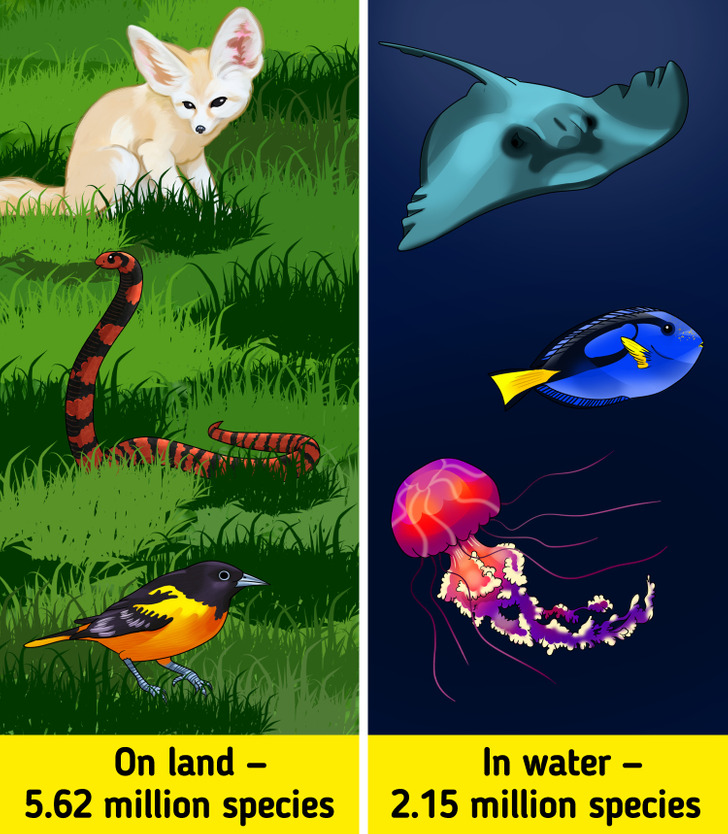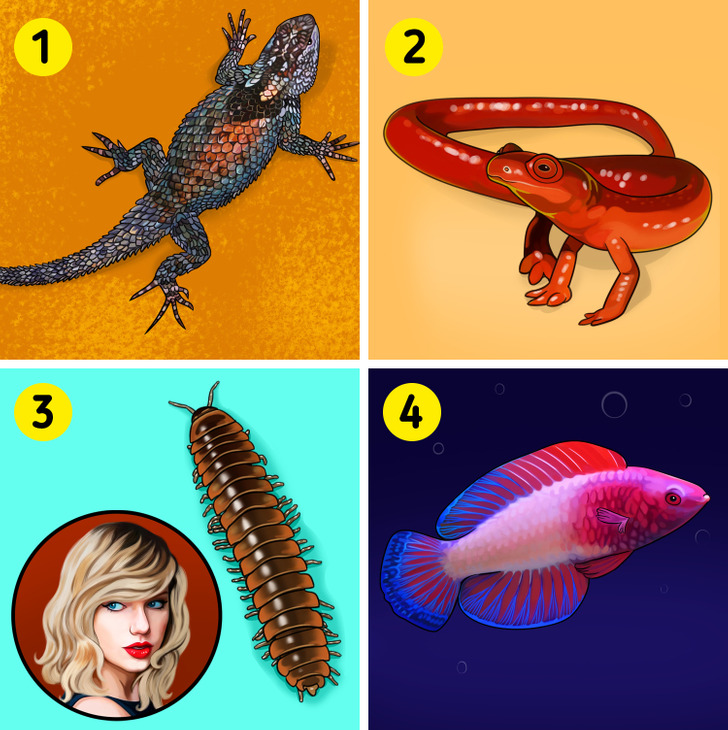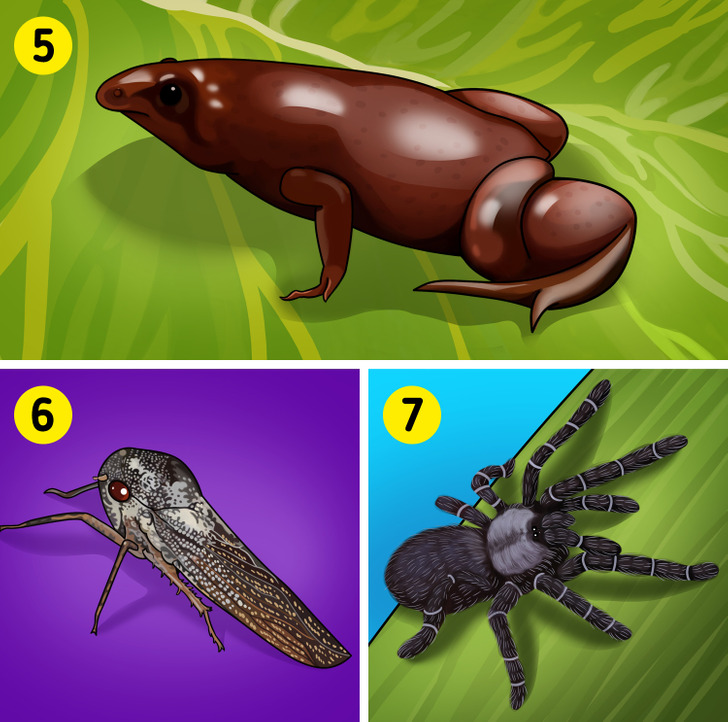A Guide to How Many Animals There Are on Earth, and What New Species Were Discovered in 2022

People are aware of only a small part of Earth’s animal species and it would be impossible to figure out the exact number. At the same time, we should not underestimate the importance of studying global biodiversity in order to control its changes. Some species will probably even go extinct before we know they existed.
At 5-Minute Crafts, we figured out how many animal species we know about. We also learned what new discoveries have already been made in 2022. And the last section of this article deserves our special attention because it concerns all of us.
How many animal species do we know about?

The number of species that scientists have been able to identify and give names to is strikingly different from the real number. In fact, we know only a small fraction of the actual number of Earth’s total animal species. There are too many of them, so studying them takes a lot of time.
The International Union for Conservation of Nature (IUCN) keeps track of the number of described species and updates the data annually based on the latest work of taxonomists. As of 2021, 2.13 million species were recorded across the planet. Based on the diagram above, we can see the numbers of identified species in some taxonomic groups. For example, there are 1.05 million identified species of insects, 36,000 species of fish, 11,000 species of birds, 11,000 species of reptiles, and more than 6,500 species of mammals.
The numbers can be slightly bigger than the real numbers because duplicates will inevitably appear. Scientists monitor this and constantly remove duplicate data, but new species are often added faster than duplicates can be found. We can say that about 20% of the described species are just copies of each other.
Assuming that this is true and 20% of the duplicates do exist, there are approximately 1.7 million species.
How many animal species are there on Earth, in reality?

In 2011, marine ecologist Camilo Mora, from the University of Hawaii, and his Canadian and British colleagues suggested that the higher taxonomic classification of species follows a consistent and predictable pattern. Taking this into account, they were able to estimate the total number of species in in a taxonomic group.
The results showed that there are about 8.7 million species of eukaryotes on Earth. At the same time, it was found that about 86% of the existing species on land and 91% of species in the ocean have not yet been discovered and recorded in the database.
Note that the study refers to the total number of eukaryotic species. As for the animal kingdom, they are given first place in terms of the amount of species diversity in their domain compared to fungi, plants, bacteria, and other organisms.
In total, there are about 7.77 million species of animals. It’s assumed that 5.62 million of them live on land, and 2.15 million live in water.
What new species were discovered in 2022?

1. A new species of spiny lizard — Sceloporus huichol. Scientists examined specimens from 8 museums and university collections and found differences in morphology, color patterns, and genetics from similar species, as well as habitat preferences. Sceloporus huichol lives in the semi-xeric pine and oak forests in the mountains of Nayarit and Jalisco in west-central Mexico. The term “huichol” honors the Huichol tribe of Mexico who live where this species of lizard is found.
2. Fire salamander — Bolitoglossa cathyledecae. This species can be distinguished from its close relatives by color, webbing on its hands and feet, and the number of upper teeth that it has. Scientists note that it’s classified as critically endangered. They discovered this salamander in Panama, in the Chiriquí province. And it was named after the conservationist Cathy Ledec.
3. Millipede — Nannaria swiftae. One of the key differences that the researchers found was the morphology of the male’s modified legs, which are used for mating. 17 new species were found in the valleys of the Appalachian Mountains. The scientific name honors popular singer and songwriter Taylor Swift. This unusual choice is explained by the fact that Dr. Derek Hennen, lead author of the study, is a fan of hers. He previously named another millipede species, Nannaria marianae, after his wife Marian, as “a small thank you for all her patience when we’re taking a nature hike and I stop to look for millipedes.”
4. Rose-veiled fairy wrasse — Cirrhilabrus finifenmaa. It was originally thought to be an adult of a different fairy wrasse species, but further analysis showed that it was a separate species. It’s found off the coast of the Maldives. The name is derived from the local Dhivehi language, and means “rose.” This is a tribute to both the national flower of the Maldives and the stunning pink hues of the wrasse.

5. Tapir frog — Synapturanus danta. It was discovered in the Putumayo Basin of Peru by researchers doing a “rapid inventory.” They spent only a few days at each site and stumbled upon a juvenile frog during their first night exploring an area of Amazonian peatland, a rare and understudied habitat. Many people on social media compared it to chocolate frogs from the Harry Potter books and films. But the name — tapir frog — comes from the tapir-like nose.
6. Leafhopper — Phlogis kibalensis. This species was discovered by entomologist Dr. Alvin Helden. During a student field trip, he visited the rainforest of the Kibale National Park in Uganda to document the insects to be included in field guides. One of them caught his attention with its metallic sheen. The second part of the species name — kibalensis — refers to the Kibale National Park.
7. Tarantula — Taksinus bambus. It was discovered by popular blogger JoCho Sippawat, who has over 2.7 million followers. Taksinus bambus lives inside a bamboo shoot or stem. Since the tarantula can’t make a hole in such a hard material on its own, it uses those made by other invertebrates, small mammals, or the natural process that causes bamboo to crack. This species can only be found in high hill forests in the northern part of Thailand. The name “Taksinus” honors the Thai king Taksin the Great who used to be the governor of the Tak province, where this spider was found.
What is important to know and remember?

The world is facing a mass extinction of species. All species of mammals, birds, reptiles, amphibians, arthropods (insects and arachnids), fish, crustaceans, coral, and other cnidarians have been greatly reduced. In part, it is human civilization that has a negative impact on most living beings. Scientists estimate that we are losing 10,000 times more species per year than the normal rate.
There is no denying that humans are destroying the natural environment at an unprecedented and alarming rate. According to a WWF report, the average decline in bird, amphibian, mammal, fish, and reptile populations has been quantified at 68% since 1970. Today, catastrophic consequences for the planet’s population and its fauna are closer than ever.
The species that are close to extinction include:
2) saola
6) vaquita
7) Sunda tiger
And this is only a tiny part of the animals that will soon disappear from the Earth.
You may think that preventing animal extinction is a job beyond your capabilities. But there are things you can do to help wildlife around the world right now:
- Learn about endangered species in your area, and tell your friends and family about them.
- Volunteer at a local nature center or wildlife sanctuary.
- Don’t use herbicides and pesticides in your yard and garden.
- Feed your pets indoors, don’t leave their bowls outside to avoid attracting wild animals.
- Reduce water use in your home and garden so that the animals that live nearby have a better chance of survival.
- Attach stickers to windows to prevent bird collisions.
- Grow plants that attract native insects for pollination. Other plants can attract invasive species which compete with native species for resources and habitat.
- Slow down while driving and be vigilant.
- Properly dispose of garbage and buy environmentally-friendly goods.
- Minimize the use of palm oil, because the forests where tigers live are cut down to plant palm plantations.
- Support an organization that protects endangered species.
- Set an example for others — this is the most effective way to draw attention to the problem and solve it together.